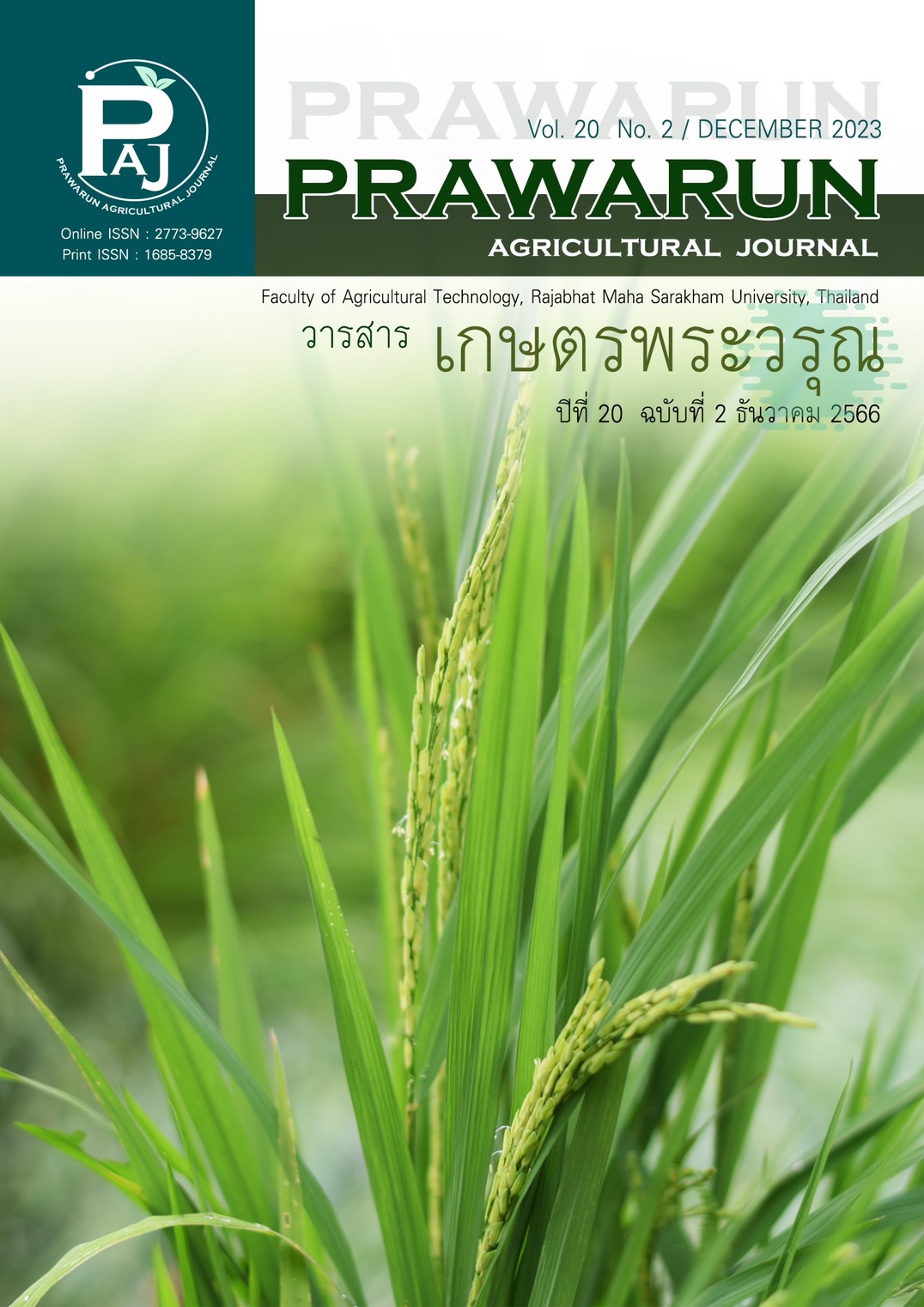สมรรถภาพการเจริญเติบโตและคุณภาพซากของไก่ศรีวิชัยและไก่ศรีวิชัยลูกผสม
Main Article Content
บทคัดย่อ
การทดลองนี้มีวัตถุประสงค์เพื่อศึกษาสมรรถภาพการเจริญเติบ องค์ประกอบซากและคุณภาพซากของไก่คอล่อนศรีวิชัยและไก่คอล่อนศรีวิชัยลูกผสม วางแผนการทดลองแบบสุ่มในบลอคสมบูรณ์ Randomized Complete Block Design : RCBD ใช้ลูกไก่คละเพศ (ไก่คอล่อนศรีวิชัย ไก่คอล่อนศรีวิชัยลูกผสมระดับสายเลือด 75:25 และ 50:50 (ไก่คอล่อนศรีวิชัย:ไก่เนื้อ) อายุ 1 วัน จำนวน 180 ตัว แบ่งออกเป็น 3 กลุ่มๆ ละ 4 ซ้ำๆ ละ 15 ตัว แบ่งการศึกษาเป็น 0-3, 4-6, 7-9, 10-12 สัปดาห์ ให้อาหารที่มีระดับโปรตีน 21 19 17 และ 15 เปอร์เซ็นต์ ไก่คอล่อนศรีวิชัยลูกผสมที่ระดับสายเลือด 50:50 มีน้ำหนักตัวเพิ่มสูง อัตราการเปลี่ยนอาหารเป็นน้ำหนักตัวต่ำ ต้นทุนการผลิตไก่ 1 กิโลกรัมต่ำกว่า (P<0.01) ไก่คอล่อนศรีวิชัย และไก่คอล่อนศรีวิชัยลูกผสมที่ระดับสายเลือด 75:20 องค์ประกอบซากไก่คอล่อนศรีวิชัยลูกผสมที่ระดับสายเลือด 50:50 มีเปอร์เซ็นต์ เนื้อหน้าอกส่วน สันนอก และไขมันช่องท้อง (P<0.01) สันใน และ สะโพก น่อง (P<0.05) สูงกว่าไก่คอล่อนศรีวิชัย และไก่คอล่อนศรีวิชัยลูกผสม 75:25 ไก่คอล่อนศรีวิชัย 100:0 มีแนวโน้มการสูญเสียน้ำระหว่างการปรุงมากกว่าไก่คอล่อนศรีวิชัยลูกผสม 75:25 และ 50:50 ค่าความสว่าง (L*) ของเนื้อไก่ทุกกลุ่มใกล้เคียงกัน เนื้อไก่คอล่อนศรีวิชัยลูกผสม 75:25 และ 50:50 มีค่าค่าความแดง (a*) ดีกว่าไก่คอล่อนศรีวิชัย100:0 ในขณะที่ไก่คอล่อนศรีวิชัย 100:0 ค่าความเหลือง (b*)มากกว่าไก่คอล่อนศรีวิชัยลูกผสม 75:25 และ 50:50 ค่าความแน่นเนื้อของไก่คลอล่อนศรีวิชัยลูกผสม 75:25 มีมากกว่าไก่คอล่อนศรีวิชัย 100:0 และไก่คอล่อนศรีวิชัยลูกผสม 50:50 ความชื้นของเนื้อไก่คอล่อนศรีวิชัยและไก่คอล่อนศรีวิชัยลูกผสม มีใกล้เคียงกันอยู่ในช่วง 65.12-73.39 เปอร์เซ็นต์ ปริมาณไขมันแทรกกล้ามไก่คอล่อนศรีวิชัยลูกผสม 50:50 มีประมาณ 2 เท่าของไก่คอล่อนศรีวิชัยลูกผสม 75 : 25 และไก่คอล่อนศรีวิชัย 100:0 ตามลำดับ ปริมาณโปรตีนไก่คอล่อนศรีวิชัยและไก่คอล่อนศรีวิชัยลูกผสม 75 : 25 และ 50 : 50 มีปริมาณโปรตีนใกล้เคียงกัน ปริมาณเส้นใยอาหารทุกการทดลองมีค่าใกล้เคียงกันเช่นเดียวกับปริมาณเถ้าที่พบอยู่ระหว่าง 1.11-1.52 เปอร์เซ็นต์
Article Details
เอกสารอ้างอิง
Information and Communication Technology Center, Department of livestock Development. (2021). Database system for farmers. Accessed October 30, 2021. Retrieved from: https://opendata.nesdc.go.th/dataset/d7681470-0120-47ab-8315-5cd28b9539c8/resource/1b116b37-ce19-415d-ae04-dd734add184f/download/-2564.pdf. (in Thai)
Jaturasitha, S. (2012). Meat Technology. Ming Mueang Printing Press, Chiang Mai. (in Thai)
Fernandez, X., V. Sante, E. Baeza, E. Lebihan-Duval, C. Berri, H. Remignon, R. Babil, G.
Lepottier, N. Millet, P. Berge and T. Astruc. (2001). Post mortem muscle metabolism
and meat quality in three genetic types of turkey. Poult. Sci. 42: 462-469
Laopaiboon, B., Duangjinda, M., Vongpralab, T., Sanchaisuriya, P., Nantachai, K., & Boonkum, W. (2010).
Testing of growth performances and meat tenderness in crossbred chicken from Thai indigenous sire and commercial dam. KHON KAEN AGR. J. 38, 373-384. (in Thai)
Leotaragul, A., Prathum, C., & Morathop, S. (2009). Guidance for Customers Perception of Pradu Hangdum
Chiangmai Chicken. Full Paper. The Thailand Research Fund (TRF). Bangkok. (in Thai)
Maliwan, P., Khempaka, S., and W. Molee, (2017). Evaluation of various feeding programmes
on growth performance, carcass and meat qualities of Thai indigenous
crossbred (50%) chickens. S. Afr. J. Anim. Sci. 47(1): 16–25.
Namkhun, S., Moratop. S., Indarachot, U. and Bhambutr, S. (2001). Native chicken farming. In the
project to conserve and utilize sustainable Thai native chicken. Animal Husbandry Division, Department of Livestock Development, Ministry of Agriculture and Cooperatives, Guide to Native Chicken Farming (page 8-11). Bangkok. The Agricultural Co-operatives Federation of Thailand. (in Thai)
Prapasawat, C., Laothong, S., Leotaragul, A., Rattanachawanon, P., & Prasert, C. (2012). Economic Development of Native Chicken (Chee-Tha Pra) to Response for Career of farmers and Consumers. Full Paper. The Thailand Research Fund (TRF). Bangkok. (in Thai)
SAS Institute. (1996). SAS Procedures Guide, Release 6.3 Edition. SAS Institute Inc., Cary, NC.
p.
Sommai Klaibanmai. (2012). Production performance and carcass quality of Srivichai crossbred chickens under semi-natural rearing conditions. Report research results for the year. (2012๗. Bureau of Animal Breeding, Department of Livestock Development, Ministry of Agriculture and Cooperatives. Pages 1–10. (in Thai)
Wattanachant, C., Songsang, A., Wattanasit, S., Adulyatham, P. and Wattanachant, S. (2004). Carcass quality,
chemical composition, physical properties and textural characteristics of meat from naked-neck chicken and common Thai indigenous chicken. Prince of Songkla Univ. Songkhla, Thailand. (in Thai)
Wongsuthavas, S. & Sombun, K. (2009). Feasibility Study of the Using of Native Chicken or Native Hybrid Chicken for Commercial in Community Level: Sakon Nakhon Province. Full Paper. The Thailand Research Fund (TRF). Bangkok. (in Thai)
Xlong,Y.L., A. H. Canton, A.J.Pescatore, S.P. Blanchard and M.L. Straw. (1993). Variation in
muscle chemical composition pH and protein extract ability among eight different
broiler carcass. J. Poult.Sci. 72:583-588.


